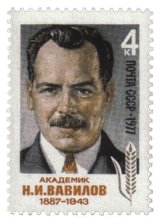
By 1941 Russian botanist Nikolai Vavilov had created the largest seed bank in the world, a collection of 400,000 seeds, roots, and fruits whose genetic material held the future of Soviet agriculture. Unfortunately it was located in Leningrad, which Hitler encircled that summer and began to starve.
The siege of Leningrad lasted two years and cost more than a million lives, and Vavilov’s scientists endured it surrounded by edible plants. “As they slowly starved, they refused to eat from any of their collection containers of rice, peas, corn and wheat,” two survivors remembered in 1993. “They chose torment and death in order to preserve Vavilov’s gene bank.”
The collection filled 16 rooms, in which no one was allowed to remain alone. Workers stored potatoes in the basement and guarded them in shifts, “numb with cold and emaciated from hunger.” Botanist Dmitri Ivanov died preserving thousands of packets of rice; peanut specialist Alexander Stchukin died at his writing table. In all, nine scientists and workers chose to die of starvation rather than eat the plants. Vavilov himself died in a labor camp in 1943, but today his bank is the largest collection of fruits and berries in the world.
(Thanks, Mike.)
